Fujifilm Finepix F300 EXR Review
Fujifilm Finepix F300 EXR Usability - How easy is it to use?
This travel-zoom allows for a secure grip thanks to a small rubberized grip at the front and a protrusion below the mode-dial to prevent the thumb from slipping off. This is a very good design and certainly one of the best ones among such small cameras. There are also 6 rubber dots below the thumb to help with traction. Added security is provided by a sturdy wrist-strap. Unlike previous models, the new strap has no tightening element.
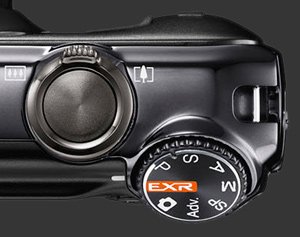 The shutter-release and surrounding zoom controller are easy to use and very responsive. The two-stage shutter-release has a distinct half-way point with short-travel to the full-press. Photographs are taken nearly instantly and the lens zooms rapidly from one end of the zoom-range to the other. Also, all other buttons provide instant feedback, unless the camera is writing an image to memory which is indicated by an orange light. The power button is located on top near the zoom controller.
The shutter-release and surrounding zoom controller are easy to use and very responsive. The two-stage shutter-release has a distinct half-way point with short-travel to the full-press. Photographs are taken nearly instantly and the lens zooms rapidly from one end of the zoom-range to the other. Also, all other buttons provide instant feedback, unless the camera is writing an image to memory which is indicated by an orange light. The power button is located on top near the zoom controller.
The mode-dial is mounted at a 45° angle so that it is easily accessible from the top or back of the camera. It contains 8 positions. Half the positions are occupied the standard PASM modes which are found on most cameras with manual-controls. There is a completely automatic mode, labeled with an icon of a camera. The other three positions group several modes together. Selecting a specific mode therefore involves rotating the mode dial and then selecting a specific mode from the menu system. The headline EXR mode, for example, has 4 specific modes: Auto, HR, SN and DR. Auto selects both a scene-mode and a EXR-mode for each picture. The chosen mode is displayed on the LCD when the shutter is pressed halfway. The mode-dial is easy to use and turn when holding the camera. The one downside of its location is that it sometimes turns accidentally as its click-stops are a bit too soft.
The remaining camera controls are located on the rear of the Fuji F300 EXR. Most of them are straight forwards:
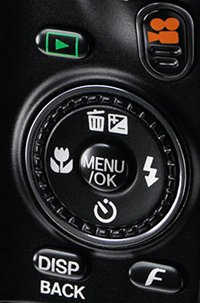
- Play enters Playback mode
- Video Record starts and stops video recording
- Disp cycles over display modes
- F enters the Finepix menu
Video recording is triggered by the dedicated button alone. There is no mode to set. Up to now this has been poorly implemented but Fuji almost succeeded here. Video recording starts with a 1 second delay and framing is possible by enabling HD guides using the display button. This is extremely important because HD video has a 16:9 aspect-ratio while images are usually captured with a 4:3 aspect. Since the camera has no video-mode, it cannot know in advance when video will be shot, so it shows the image preview. To frame for recording video, the user has to make sure that the subject falls between the blue HD guides. Without those guides or a dedicated video mode, setting up framing correctly is nearly impossible.
There is also a 4-way controller which is surrounded by a skinny dial. All directions on the 4-way controller are assigned a function: up activates exposure-compensation, right cycles through flash-modes, down cycles between self-timer (Off, 2s, 10s, Face-Detect) and left toggles macro mode. The central button is used to activate the menu system and to confirm menu-selection. The dial is used to set exposure parameters, cycle through options and move between images in playback mode.
The Finepix menu has lost some of its options. There are now 3: ISO, image size and film-simulation. Too bad white-balance and dynamic-range are gone from there. Film-simulation selects between Provia, Velvia, Astia, B&W and Sepia. Provia is what the natural default setting. Velvia produces high-contrast images with vivid colors. Astia produces lower contrast images with subdued colors.
The Fuji F300 EXR's capabilities are spread across various modes. This is where things get rather twisted, particularly in EXR mode. In non-EXR modes, the F300 normally uses its sensor's HR mode, meaning that all photosites are read simultaneously and each one is turned into a pixel. In these modes, this Fuji can be set to output images at 12, 6 or 3 MP. The camera does not give any indication of which EXR mode is used when shooting below 12 megapixels. It does give some hints though by enabling a different set of dynamic-range options when the flash is off though. It would be preferable if things were clearly shown.
P mode is automatic. ISO can be set from 100 to 1600 at full-resolution and up to 12800 at lower-resolutions. Since the Fuji F300 EXR does not actually have a physical aperture, it simulates the reduction of light by sliding one of two neutral-density filters. This implies that changing aperture does not affect the depth-of-field and that, at any point, only three aperture options exist. This is why Shutter-Priority mode does not allow ISO to be fixed: There are too few aperture settings to allow selection of ISO and shutter-speed and still be able to expose the image correctly. Because the Fuji Finepix F300 EXR exposes for the brightest image area, all dynamic-range options are not always available. At ISO 100, only 100% dynamic-range can be used, at ISO 200 options for dynamic-range expand to 200%. Between ISO 400 and 3200, up to 400% dynamic range can be chosen. At ISO 6400 and 12800, only 100% dynamic range is supported.
M mode is fully manual. This mode lets the photographer set aperture, shutter-speed and ISO independently, although the 3 aperture settings do not affect depth-of-field due to the lack of a physical aperture. Still, the Fuji F300 EXR has an excellent exposure latitude considering ISO goes up to 12800 and shutter-speed down to 8s. The thin dial around the 4-way controller is used to change shutter-speed or aperture, depending on which one is highlighted. To change between the two, simply press the Up direction.
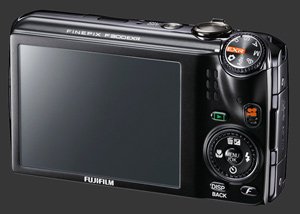
Auto is the fully-automatic mode. It does not allow ISO, DR, WB or EC to be selected. It does allow the ISO limit to be set between 400 and 1600. There are 18 scene-modes available, all of them automatic but several now allow EC to be set, surely a very welcome improvement for those who use these modes.
The EXR mode has 4 sub-modes: Auto, HR (Resolution Priority), SN (High-ISO and Low Noise) and DR (Dynamic Range). Auto-EXR mode is as close to magic as any camera technology ever was. It takes full-control of the camera, including activating continuous-autofocus, scene-mode recognition, auto image size selection, face-detection and disabling EC, WB and ISO settings. Not only that, Auto-EXR drains the battery at super-speed. Still, image aspect ratio can be selected between 4:3, 3:2 and 16:9. Image quality, the self-timer and the flash-mode can be set too.
HR mode is nearly identical to automatic P mode, the notable difference being that ISO is limited to 800 max. Resolution can be set to either 12, 6 or 3 megapixels with 4:3, 3:2 or 16:9 aspect ratio. It is not clear why 6MP HR mode would be any different than 6MP SN mode. SN mode limits resolution to 6 megapixels and ISO to 1600. This time it is not clear why SN mode cannot use ISO 3200 to 12800, nor can dynamic-range be changed in HR and SN modes, it is fixed at 100% instead.
DR mode allows the selection of dynamic-range from 100% to 800%, which represents 3 extra stops beyond the F300 EXR's base dynamic-range. Resolution is limited to 6 megapixels and only automatic ISO settings (400 to 1600 max) can be selected. White-balance, exposure-compensation, macro mode and self-timers can be set as well. The Flash-mode is fixed to off though. Now, it is expected that expanded dynamic-range not be available at high-ISO due to high noise-levels, however it is too bad that DR mode is mutually exclusive with manual controls and that shutter-speeds slower than 1/4s are not achievable in this mode.
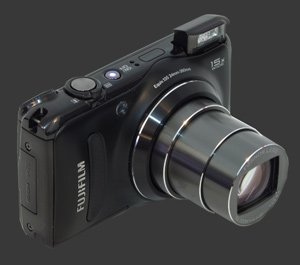
The flash automatically pops up when this digital camera is powered on. Being where it is, it feels slightly annoying to have to keep it down or stay clear of it. The good side of this is that the flash itself can be used as a direct-control. When the flash is pushed down, the camera turns it off automatically. So, to alternate between flash and non-flash photography, you may turn the flash on and simply keep it down when it is not wanted.
The full menu of the Fuji Finepix F300 EXR is organized in two tabs, one for the camera menu and the other for the setup menu. The 3" LCD screen is excellent with a new slim design that increases contrast and dynamic-range. The anti-reflective coating really does its job well. With a resolution of 460K pixels, images on the screen are sharp and motion is fluid. The preview is close to being exposure-priority, with some variance in low-light. When the shutter is half-pressed though, the image darkens when the camera needs to use an ND filter to simulate a small aperture.
This camera is well constructed with a sturdy plastic body. Both battery and memory are found behind the compartment door. The battery is held in place with a latch so that it does not fall out while changing memory cards. Another nice touch is that the latch is colored yellow, as is one side of the battery to know which way to insert it. The Fuji Finepix F300 comes with a charger for its battery. This is better than in-camera charging which locks down the camera while a battery is being charged. This camera uses SD-HC memory cards. There is a metal tripod-mount in the center of the camera which is good for balance but not ideal for panoramas.
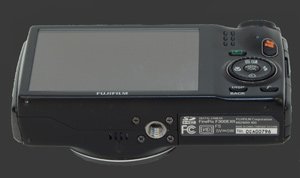
Speaking of panoramas, the Motion Panorama 360 mode is quite cool. It works by capturing image-slices and forming a panorama that spans 360, 240 or 120 degrees in any direction. The camera reduces the field-of-view in this mode to account for imperfect sweeping motion. It then produces a low-resolution panorama right in the camera. While the previous motion panorama was extremely difficult to capture, this one is a breeze. A guide and horizon line appears on the screen to guide the sweeping motion. When a sufficiently large arc is traced, the camera automatically starts assembling the whole thing. It takes a few seconds to do so. The results are not perfect but show an impressively wide view from a distance. Due to the reduced angle-of-view, these long panoramas are best suited for subjects that are relatively flat. Also, it is naturally difficult for any 360 panorama to be perfectly exposed all around. Using a computer one can assemble much higher-resolution panoramas but it often takes several minutes or even hours for a similar panorama.
 Click to view full-size this 360° Motion Panorama sample.
Click to view full-size this 360° Motion Panorama sample.
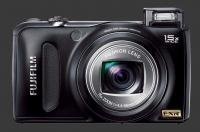 |
Please Support Neocamera
All information on Neocamera is provided free of charge yet running this website is a huge endeavor. Purchases made via affiliate links found throughout the site help keep it running and up-to-date. There is no additional cost to you, so please consider buying via these links to our affilates:
If you found any information on this site valuable and did not purchase via our affiliate links, please considering donating via PayPal:
Any amount will be greatly appreaciated. Thank you for your support!
Fujifilm F300 EXR Highlights

Sensor-Size: 8 x 6mm

Actual size when viewed at 100 DPI
| 12 Megapixels Travel Zoom | ISO 100-3200 |
| 15X Ultra-Wide Optical Zoom | Shutter 1/2000-8s |
| Built-in Stabilization | Full manual controls |
| 1.5 FPS Drive, 5 Images | Custom white-balance |
| 1280x720 @ 24 FPS Video Recording | Spot-Metering |
| 3" LCD 460K Pixels | Lithium-Ion Battery |
| Secure Digital High Capacity, Internal Memory |
Updates
2024.08.07

Eye Protection Tips for Professional Photographers
The four main considerations for professional photographers regarding eyewear.
2024.07.14

Fujifilm X100VI Review
Flagship fixed-lens compact digital camera with a 40 MP sensor and Image-Stabilization, a first for the series. Retro design featuring dual control-dials, plus direct ISO, Shutter-Speed and EC dials. Its hybrid viewfinder can switch between EVF and OVF mode.
2024.05.09

Fujifilm GFX100 II Review
Flagship 102 Megapixels Medium-Format Mirrorless Digital Camera with 8-Stop 5-Axis IBIS, 8 FPS Drive, 8K Video and 400 MP Super-Resolution capture in a weatherproof and freezeproof body with dual control-dials and dual memory-card slots.
2024.04.03

Fujifilm X-T5 Review
Newest Fujifilm flagship boasting a 40 MP APS-C sensor, 5-axis IBIS with 7-stop efficiency, 15 FPS continuous drive, 6.2K Video capture, dual control-dials and dual SDXC UHS-II slots in a sturdy weatherproof and freezeproof body.
2023.11.20

Best Digital Cameras of 2023
Find out which are the Best Digital Cameras of 2023. All the new Mirrorless Digital Cameras from entry-level to high-end professional.
2023.07.10

Fujifilm X-H2 Review
40 Megapixels APS-C Hybrid Mirrorless Digital Camera with 7-stop IBIS. Fastest shutter ever and 8K video capture. Large builtin EVF with 0.8X magnification and 5.8 MP, plus an Eye-Start Sensor. Packed with features and large number of controls in a weatherproof and freezeproof body.
2023.05.07

Sony FE 20-70mm F/4G Review
Review of the unique Sony FE 20-70mm F/4G lens. The optical zoom of this lens spans ultra-wide-angle and medium focal-length coverage, making it one of the most versatile Full-Frame lenses on the market.
2023.01.15

Huion Inspiroy Dial 2 Review
Review of the Huion Inspiroy Dial 2 tablet, a medium sized drawing surface with dual dials and customizable buttons. Connects via USB-C or Bluetooth 5.0 with Windows, Linux and Android support.
2022.12.08

How to Pack for a Photo Trip
Find out how to pack for a travel photography trip, carry your gear safely while meeting airline regulations.
2022.11.13

Best Digital Cameras of 2022
The best digital cameras of 2022. A short list of the most outstanding models in their respective categories. Choose one for yourself or as a gift.
2022.09.21

Pentax DA* 60-250mm F/4 SDM Review
Review of the Pentax DA* 60-250mm F/4 SDM, the constant-aperture telephoto zoom with the highest zoom-ratio on the market.
2022.09.20

Pentax DA* 50-135mm F/2.8 SDM Review
Review of the Pentax DA* 50-135mm F/2.8 SDM, the lightest professional telephoto zoom native to the K-mount.











